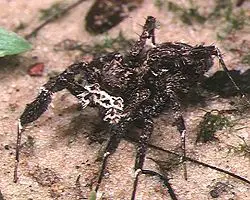The Portia group of spiders contains 15 species of African, Asian and Australian jumping spiders measuring up to 10 millimetres or 0.39 inches. Odd in appearance, it resembles a scrap of vegetation. Rather than scurrying about like other jumping spiders, the Portia has slow, choppy gait, much like robots in science fiction movies. The Portia is one of nature’s most versatile predators.
Table of Contents
Habitat:
Unlike most other spiders which spin webs and settles within its own environment, the Portia is a creature whose predatory reputation is legendary. It is very intelligent and makes its home in his prey webs. With its ability to mimic and detour with deception to capture the resident spider. In many cases where a spider can sense a Portia, they panic and abandon their webs.

Basically, where web building spiders are found is generally where the Portia Spider can be found. They prefer leafy areas in warm climates. This spider also does a lot of walking. They can spin silk shelters or nests which are usually densely woven in a tubular shape.
Prey:
The Portia Spider prefers other spiders to insects. One if the Portia’s specialities is invading another spider’s web and eating the spider. It stands on another spider’s web and plucks at the silken threads, imitation the vibrations made by mosquitoes. They will also eat spider egg sacs. It pounces on its victim after hours of stalking and injects a broad spectrum venom capable of killing virtually any insect and spider. With the ability to trick just about any kind of web building spider, it can capture spiders from one tenth to twice its size.
Breeding:
The male spider shows off to the female by stiffly extending and shaking its fore legs. The female then drums and tugs the web. The breeding can take place in or out of the web. When the male comes closer, the female may however, not mate but lunges out and kills him. In other cases, she will mate first and then kill him. Some types of female Portia Spiders lets the male mount her and ten she drops on a dragline with the male onboard, where she may swing around and eat him. The Portia uses trickery to capture even their own species to mate. The eggs can be some potential food for a rival. Another female Portia is more likely to be the predator because cannibalism is so frequent with the Portia.
Venom:
The venom is only lethal to insects. Humans will not be affected if bitten. The size of these spiders indicates that humans will not receive a nasty bite if bitten.
Interesting Facts:
Portia Spiders mimic or copy the habit of other spiders. They have been reported to be very smart little spiders with amazing abilities. The Portia has eight eyes, a large pair up the front which gives them excellent vision and the ability to see colour, three smaller, less obvious pairs in rows from front to back along the top of its head, allowing them to sense light and motion. These spiders are notes for being one of nature’s most efficient serial killers and are no bigger than a small button.
By Jennifer
BIBLIOGRAPHY:
1. Jackson, R.R Cues for web invasion and aggressive mimicry signalling in Portia, Journal of Zoology, London 236:131-149
2. Jackson, R.R and S.D Pollard, 1996 Predatory behaviour of jumping spiders, annual review of entomology.
3. Jackson, R.R and R.S Wilcox, 1994, Spider flexibilty.
4. Photo: Portia fimbriata – Wikimedia.org
Information and pictures were taken from children’s projects and where credited to that child does not claim to be original information. Where possible, permission to reproduce has been sought. Any infringement of copyright is purely unintentional.

